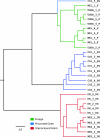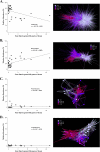Community structures of fecal bacteria in cattle from different animal feeding operations
- PMID: 21378055
- PMCID: PMC3126396
- DOI: 10.1128/AEM.02988-10
Community structures of fecal bacteria in cattle from different animal feeding operations
Abstract
The fecal microbiome of cattle plays a critical role not only in animal health and productivity but also in food safety, pathogen shedding, and the performance of fecal pollution detection methods. Unfortunately, most published molecular surveys fail to provide adequate detail about variability in the community structures of fecal bacteria within and across cattle populations. Using massively parallel pyrosequencing of a hypervariable region of the rRNA coding region, we profiled the fecal microbial communities of cattle from six different feeding operations where cattle were subjected to consistent management practices for a minimum of 90 days. We obtained a total of 633,877 high-quality sequences from the fecal samples of 30 adult beef cattle (5 individuals per operation). Sequence-based clustering and taxonomic analyses indicate less variability within a population than between populations. Overall, bacterial community composition correlated significantly with fecal starch concentrations, largely reflected in changes in the Bacteroidetes, Proteobacteria, and Firmicutes populations. In addition, network analysis demonstrated that annotated sequences clustered by management practice and fecal starch concentration, suggesting that the structures of bovine fecal bacterial communities can be dramatically different in different animal feeding operations, even at the phylum and family taxonomic levels, and that the feeding operation is a more important determinant of the cattle microbiome than is the geographic location of the feedlot.
Figures







Similar articles
-
Comparison of the microbial community structures of untreated wastewaters from different geographic locales.Appl Environ Microbiol. 2013 May;79(9):2906-13. doi: 10.1128/AEM.03448-12. Epub 2013 Feb 22. Appl Environ Microbiol. 2013. PMID: 23435885 Free PMC article.
-
A Meta-analysis of Bacterial Diversity in the Feces of Cattle.Curr Microbiol. 2016 Feb;72(2):145-151. doi: 10.1007/s00284-015-0931-6. Epub 2015 Nov 6. Curr Microbiol. 2016. PMID: 26542532
-
Animal-to-animal variation in fecal microbial diversity among beef cattle.Appl Environ Microbiol. 2010 Jul;76(14):4858-62. doi: 10.1128/AEM.00207-10. Epub 2010 May 14. Appl Environ Microbiol. 2010. PMID: 20472731 Free PMC article.
-
Influence of wet distillers grains diets on beef cattle fecal bacterial community structure.BMC Microbiol. 2012 Feb 24;12:25. doi: 10.1186/1471-2180-12-25. BMC Microbiol. 2012. PMID: 22364310 Free PMC article.
-
Dysbiosis of the fecal microbiota in feedlot cattle with hemorrhagic diarrhea.Microb Pathog. 2018 Feb;115:123-130. doi: 10.1016/j.micpath.2017.12.059. Epub 2017 Dec 21. Microb Pathog. 2018. PMID: 29275129
Cited by
-
The diversity of the fecal bacterial community and its relationship with the concentration of volatile fatty acids in the feces during subacute rumen acidosis in dairy cows.BMC Vet Res. 2012 Dec 6;8:237. doi: 10.1186/1746-6148-8-237. BMC Vet Res. 2012. PMID: 23217205 Free PMC article. Clinical Trial.
-
Fermented total mixed ration enhances nutrient digestibility and modulates the milk components and fecal microbial community in lactating Holstein dairy cows.Front Vet Sci. 2024 Aug 14;11:1408348. doi: 10.3389/fvets.2024.1408348. eCollection 2024. Front Vet Sci. 2024. PMID: 39205803 Free PMC article.
-
Investigating Effects of Tulathromycin Metaphylaxis on the Fecal Resistome and Microbiome of Commercial Feedlot Cattle Early in the Feeding Period.Front Microbiol. 2018 Jul 30;9:1715. doi: 10.3389/fmicb.2018.01715. eCollection 2018. Front Microbiol. 2018. PMID: 30105011 Free PMC article.
-
Large-scale implementation of standardized quantitative real-time PCR fecal source identification procedures in the Tillamook Bay Watershed.PLoS One. 2019 Jun 6;14(6):e0216827. doi: 10.1371/journal.pone.0216827. eCollection 2019. PLoS One. 2019. PMID: 31170166 Free PMC article.
-
Investigation of a Reduction in Tylosin on the Prevalence of Liver Abscesses and Antimicrobial Resistance in Enterococci in Feedlot Cattle.Front Vet Sci. 2020 Feb 28;7:90. doi: 10.3389/fvets.2020.00090. eCollection 2020. Front Vet Sci. 2020. PMID: 32185186 Free PMC article.
References
-
- Archibeque S. L., Miller D. N., Freetly H. C., Ferrell C. L. 2006. Feeding high-moisture corn instead of dry-rolled corn reduces odorous compound production in manure of finishing beef cattle with decreasing performance. J. Anim. Sci. 84:1767–1777 - PubMed
-
- Armstrong G. L., Hollingsworth J., Morris J. G. 1996. Emerging foodborne pathogens: Escherichia coli O157:H7 as a model of entry of a new pathogen into the food supply of the developed world. Epidemiol. Rev. 18:29–51 - PubMed
-
- Benenson A. S. 1995. Control of communicable diseases manual, 16th ed. American Public Health Association, Washington, DC
Publication types
MeSH terms
Substances
LinkOut - more resources
Full Text Sources
Other Literature Sources
Medical

